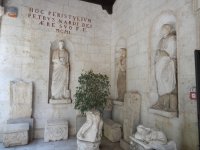Etruscan Tuscany in Chiusi
 On a trip to Tuscany this past summer, I decided to make a stop in a city I’ve always seen from the highway but have never managed to visit.
On a trip to Tuscany this past summer, I decided to make a stop in a city I’ve always seen from the highway but have never managed to visit.
The area is known for its Etruscan civilization. The ancient city of Clusium, or Clevsim in Etruscan, was one of the most powerful cities in the Etruscan League before it was conquered by Rome in the 3rd century BC.
 Today, Chiusi boasts a small, but impressive, Etruscan Museum. I happened to be visiting the first Sunday of the month, so I was even lucky enough to be able to visit this impressive museum for free.
Today, Chiusi boasts a small, but impressive, Etruscan Museum. I happened to be visiting the first Sunday of the month, so I was even lucky enough to be able to visit this impressive museum for free.
Chiusi’s National Etruscan Museum dates back to 1871, and it has an impressive display of artifacts.
 Although I’ve visited the wonderful Etruscan museums of Villa Giulia in Rome and the Tarquinia museum, it was the first time I saw such a wide selection of the ‘canopic urns’ typical of the region – and there are many in excellent condition on display.
Although I’ve visited the wonderful Etruscan museums of Villa Giulia in Rome and the Tarquinia museum, it was the first time I saw such a wide selection of the ‘canopic urns’ typical of the region – and there are many in excellent condition on display.
In Chiusi and the surrounding areas, the Etruscans cremated their dead and would place the ashes in urns. The urns would be closed with a lid in the form of the head of the deceased, to which wigs, jewels and even helmets for soldiers would have been added.
 There are impressive tomb displays and the excellent explanations – in Italian and English – provide fascinating information about ancient Etruscan life. Well worth a visit when you are travelling through the region.
There are impressive tomb displays and the excellent explanations – in Italian and English – provide fascinating information about ancient Etruscan life. Well worth a visit when you are travelling through the region.
Also worth seeing in Chiusi is the Romanesque cathedral of San Secondiano, built in 560 AD and renovated in the 13th century. When we were there, there was a music festival taking place in its airy entry piazza.
For more travel tips around Tuscany, see my earlier posts on the imposing castle of Radicofani, visiting medieval Sarteano, views from the top of the volcano-mountain Monte Amiata, relaxing in the thermal baths of San Filippo ai bagni, the medieval fortress of Abbadia di San Salvatore and its medieval festival, and exploring Napoleon’s Empire: the island of Elba.

